高中英语公开课 Computers_Reading_
高中英语 必修二 Unit3 《Computers ---Reading》

Para I:
Over time I have been changed quite a lot.
Who am I?
Para II:
These changes only became possible as my memory improved.
Since the 1970s many new applications
Discuss it with your deskmate.
watch movies
search for information
chat with friends
read books and
magazines
shopping online
play games
Reading
Who am I?
Go over the story to find out who the speaker is. Underline three sentences to support your idea.
Two short VCRs about the latest development of the computer.
Discussion
In what ways computers can be used to do for human race in the future?
work for us in Mars and the moon
F The information was stored in tubes, then on •traTnhseisotoldresraInadmla,ttehreolnartgheercIhhipavse. become. As I have grown older I have also grown
高中英语_Computers(Reading)教学设计学情分析教材分析课后反思
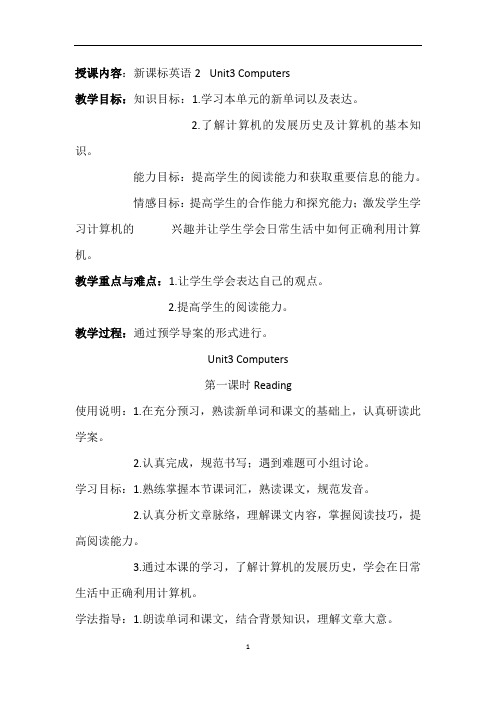
授课内容:新课标英语2Unit3 Computers教学目标:知识目标:1.学习本单元的新单词以及表达。
2.了解计算机的发展历史及计算机的基本知识。
能力目标:提高学生的阅读能力和获取重要信息的能力。
情感目标:提高学生的合作能力和探究能力;激发学生学习计算机的兴趣并让学生学会日常生活中如何正确利用计算机。
教学重点与难点:1.让学生学会表达自己的观点。
2.提高学生的阅读能力。
教学过程:通过预学导案的形式进行。
Unit3 Computers第一课时Reading使用说明:1.在充分预习,熟读新单词和课文的基础上,认真研读此学案。
2.认真完成,规范书写;遇到难题可小组讨论。
学习目标:1.熟练掌握本节课词汇,熟读课文,规范发音。
2.认真分析文章脉络,理解课文内容,掌握阅读技巧,提高阅读能力。
3.通过本课的学习,了解计算机的发展历史,学会在日常生活中正确利用计算机。
学法指导:1.朗读单词和课文,结合背景知识,理解文章大意。
2.合作探究:通过小组讨论的方式解决学案中对自己来说有困难的问题。
学习过程:【模块一】课前预习案:(A级)(书面展示,个人独立完成。
)新知感悟:A.重点单词短语1.计算vt. _______________2.简化vt. ________________3.智力;聪明;智能n.________________4.解决;解答vt.____________5.私人的;个人的;亲自的 adj.____________6.完全地;整个地 adv.____________7.应用;用途;申请 n.______________8.金融;财经 n.___________9.探索;探测;探究 v._____________10.目标;目的;球门;得分 n.______________1. 有共同之处;共用_______________________2.把……与……相比 _________________________3.从那时起 ___________________________4. 走过;经过__________________5.结果 __________________6.如此……以至于…… ____________________7. 与某人分享某物____________________8. 也;和;既……又……______________________9. 高质量的______________________10. 人类___________________B.重点句型:1.before引导时间状语从句2.As引导时间状语从句3.So…that…句型设计思路:通过自主总结,提高学生的预习能力。
Unit 3 Computers Reading 课件(共74张PPT)
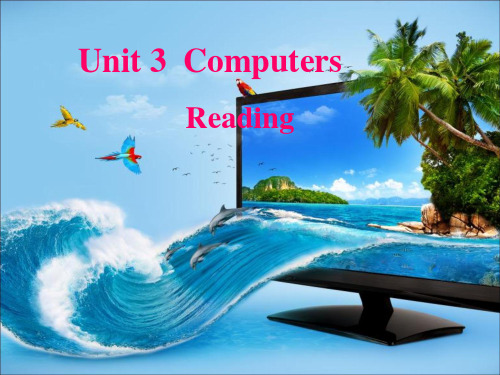
Reading
目录
1 Lead-in Pre-Reading 2
3 While-Reading Post-Reading 4
5 Review
Part I Lead-in
Getting ready
Look at the cartoon and answer the questions.
B Before you read
Look at the pictures, the title and the sub-headings of the article on
page 35. Then tick (✓) the facts that the article probably talks about.
What will happen to us if computers can do all our jobs? Will we have nothing to do? Computers may change our lives, but will they make them better?
I. Read the first part of the article and complete the table
×
Part III While-Reading
Read the text and answer the questions
Computer
Smaller and better In the 1940s, the first computers were bigger than cars. Now computers are becoming smaller and better. Some computers are tiny. You may be unaware of them. There is probably one inside your TV or washing machine. You depend on computers more than you realize.
人教版高中英语 必修二 Unit3 《Computers ---Reading》 课件 (共21张PPT)

1. an abacus
★2. a calculating machine
★3. change of my size
4. virus ★5. the Analytical Machine made by Charles Babbage
★6. transistor
7. hard disk
★8. connected by a network
software
hard disk
download
upload
website
homepage
password
virus
web fans
hacker
surf the Internet
world wide web 万维网
Now let’s come to the reading
Fast reading and pick out the items mentioned in the text.
Discussion
Every coin has two sides, so does the Internet. Now discuss the advantages and disadvantages of the computer and Internet in groups and think what we should do.
Supporting details
1. calculating machine 2. analytical machine 3. universal machine 4. pc 5. laptop
4 PC ( 2 ) analytical machine
( 5 ) laptop
高中英语Unit 3 computers-reading名师公开课市级获奖课件(人教版必修二;16张)
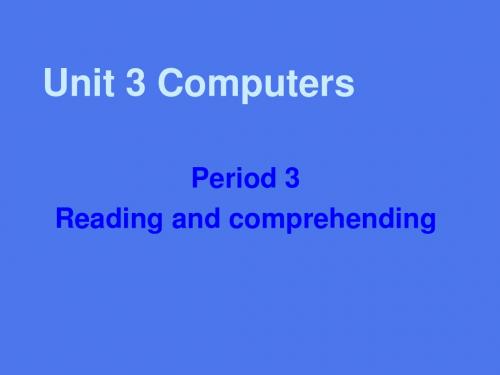
Careful reading
Timeline
1642: A __________________________ calculating machine was _______________________________ used in France. ____: the Analytical Machine was 1822 Made by Charles Babbage. Alan Turing wrote a book to 1936:___________________________ describe how computers could _______________________________ be made to work. _______________________________ 1960s:__________________________ Computers have new _______________________________ transistors and became _______________________________ smaller.
Unit 3 Computers
Period 3 Reading and comprehending
Aims:
1.Emotion, attitude and values: 1). To help students learn to read an introduction about computer 2).To help students better understand “the computer science” 3).To help students learn to use some important words and expressions 2. Knowledge aims 1). Main words and expressions. simplify sum ; operator; logically ;technological ; artificial; intelligence; personal; tube; network; web; mobile; rokets ;finance 2). Practice different reading skills, such as skimming, scanning, intensive reading, extensive reading, etc.
UNIT-3-COMPUTERS-公开课

拓展:It will be long before... 要过很久才......
strong
Para II: mThemesoercyhansgmeaslol nly belcaarmgee
possible as my memory improved.
size
large
small
Para III: applicSaitniocensthena1r9r7o0ws, manywnideew applications have been found for me.
the experiment.
A. will not be; will know B. is; will know
C. will not be; know
Dwas programmed by an operator who used cards with holes, I could "think" logically and produce an answer quiker than any person.
watering
playing
What is the robot doing?
working
What's the next development of computers?
All the inventions tell us the_d_e_v_e_lo_p_m__e_n_t of computers.
高中英语_Unit3《Computers》reading
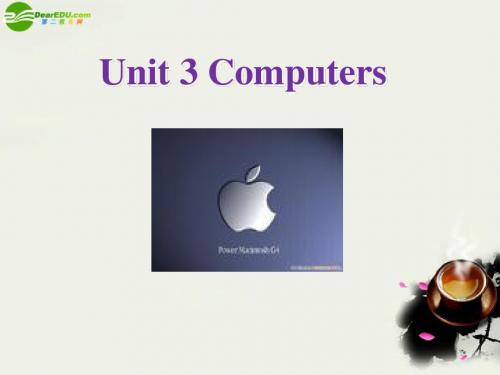
Charles Babbage 1800s analytical machine
3. Who was the next important person to design computers?
Alan T Turing 1836 universal machine Charles Babbage 1800s analytical machine
Role-play
Suppose you are a reporter. Now you are interviewing Mr. / Miss Computer. Sample questions: …… What do you like to eat? What are your hobbies? What is your newest function(功能 功能)? 功能 Can you say something about your future plan? etc.
1936
WhatTuring wrote a bookthe text? how Alan is the order of to describe
1970s Computers were brought into people's homes. . now Computers connect people all over the world
The history of computer calculating machine analytical machine universal machine
Charles Babbage
The “father” (inventor) Alan Turing PC (desktop /notebook) artificial intelligence
高中英语优秀教案:Unit3 Computers Period1 Reading优秀教案 新人教版必
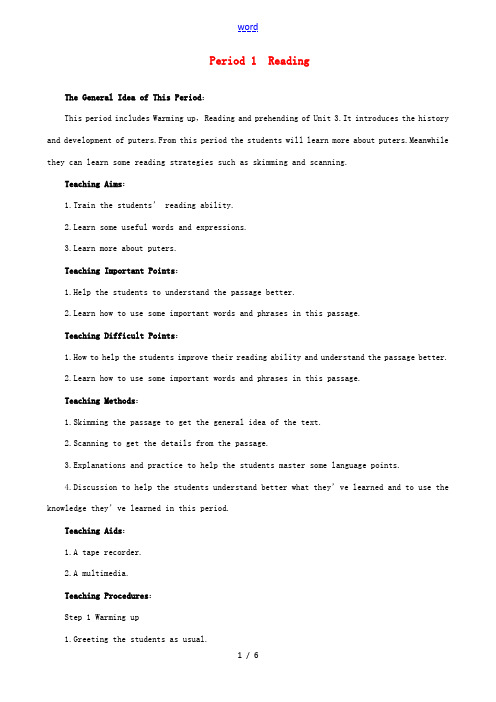
Period 1 ReadingThe General Idea of This Period:This period includes Warming up,Reading and prehending of Unit 3.It introduces the history and development of puters.From this period the students will learn more about puters.Meanwhile they can learn some reading strategies such as skimming and scanning.Teaching Aims:1.Train the students’ reading ability.2.Learn some useful words and expressions.3.Learn more about puters.Teaching Important Points:1.Help the students to understand the passage better.2.Learn how to use some important words and phrases in this passage.Teaching Difficult Points:1.How to help the students improve their reading ability and understand the passage better.2.Learn how to use some important words and phrases in this passage.Teaching Methods:1.Skimming the passage to get the general idea of the text.2.Scanning to get the details from the passage.3.Explanations and practice to help the students master some language points.4.Discussion to help the students understand better what they’ve learned and to use the knowledge they’ve learned in this period.Teaching Aids:1.A tape recorder.2.A multimedia.Teaching Procedures:Step 1 Warming up1.Greeting the students as usual.2.Introduce the topic of putersShow the five pictures (an abacus,a huge puter,a calculator,a PC,a notebook puter)and get the students name them in English.Through this task,students can have a general idea about what they are going to learn.Besides,students are expected to have a discussion about what they have in mon while looking at them.And they are required to use the given expressions in their discussion to express their ideas.T:Boys and girls,today I am going to introduce some machines to you.Now let’s see whether you can name them in English correctly,and talk about them.Now work together with your partners and try to find out what they have in mon.Two minutes late,five students are asked to talk about them in class.S1:An abacus is an old calculating machine used in China until now.S2:A huge puter is built to solve some mathematical problems.But,in my opinion,it is too big.S3:A calculator is a new calculating machine which can solve a large number mathematical problems.And I think it is very convenient to carry and use,so we often use it.S4:A PC is a personal puter,which can solve all kinds of problems and is widely used in offices,schools,shops,at homes,etc.now.S5:A notebook puter is a kind of useful puter which can be taken conveniently like a notebook.But I think it is too expensive.T:Quite good.It seems that you are all quite familiar with these machines.But can you tell what they have in mon?Any volunteers?S6:Let me try.I think they all calculate something.They can deal with some maths problems.S7:I believe that they are our good friends.With their help we can finish our work quickly.S8:The 21th century is the century of information technology.As middle school students,we should try to learn how to use puters.’s more,from the abacus to the notebook puter,there is a long way.But now puters have already changed our lives greatly.But do you know more about puters and can you say something about how puters have changed our lives.Step 2 Pre-readingShow the questions on the screen.T:Now,please have a discussion first,and then I’ll ask some students to report your work.After a few minutes.T:Now,who would like to answer the first question?Volunteer!S9:I’ll have a try.I know that puters have developed from large machines.They have been made smaller and smaller,but work faster and faster.I really can’t imagine what they will be like and whether they can take the place of human beings in the future.T:Yes,this is really a big problem.I think you are all interested in puters,you may go on studying puters,and perhaps one day you will design your own puters and bee the masters of puters.OK!Next question!S10:I think puters have changed our lives greatly.We use puters widely in our study,in our work.You are using the puter to teach us English,aren’t you?S11:In my opinion,in the modern society,using the puters means grasping a tool of controlling the world.We may municate with each other from a very long distance.In short,we can not live freely without them.T:I agree with you.The puters are being more and more important in our lives.But learning more about puters is also important,isn’t it?OK,let’s e to the reading passage “Who am I”.Step 3 ReadingTask 1.Skim the passage for the general idea.T:Boys and girls,you will be given two minutes to skim the passage and try to find out who “I” am and get the general idea of this passage.After two minutes.T:Time is up.Who would like to tell us who “I” am and give the general idea of the text to the class?Volunteer!S12:Of course,“I” am the puter.The passage is mainly about the history and development of puters.S13:The passage is also about the relationship of puters and humans.Task 2.Scan for the details.’s see who can find out the answers most quickly and correctly.1.Where were you in 1642?2.What happened to you in 1822?3.What were you called in 1936?4.What did you get in the 1960s?5.What happened to you in the 1970s?T:Have you finished?S14:I have.I was in France as a calculating machine in 1642.In 1822,I was built as an Analytical Machine by Charles Babbage.I was called “a universal machine” in 1936,as I could solve any mathematical problem.In the 1960s,I was given a family connected by a network,so that I could share information with others and we could talk to each other.In the 1970s,I was brought into people’s homes.T:You are so quick-minded that in such a short time you could find out all the answers to the questions.Your mind really works like a puter!Step 4 prehendingTask 3.Fill in the timeline to remember the facts.T:But can you memorize facts like a puter?I am afraid you can not.But let’s try to rememberthe facts in the passage by filing in the timeline on Page 19,which,I am sure,will help you remember the facts easily.Suggested answers:Timeline1642:The puter began as a calculating machine.1822:The Analytical Machine was built by Charles Babbage.1936:Alan Turing wrote a book to describe how puters could be made.1960s:puters had new transistors and became smaller.1960s:The first family of puters connected to each other.1970s:puters were brought into people’s homes.Now:puters connect people all over the world together.’m sure all of you have got them right.Now you can retell the history of puters easily with the help of the timeline,can’t you?Please have a try,boys and girls!Step 5 Homework1.Recite the key sentences.2.Prepare for Learning About Language.3.Try to retell the text using about 100 words.Step 6 The Design of the Writing on the BlackboardUnit 3 putersPeriod 1The general idea of the text:Questions1.Where were you in 1642?2.What happened to you in 1822?3.What were you called in 1936?4.What did you get in the 1960s?5.What happened to you in the 1970s?Language points:1.in mon/have... in mon (with)...2.in one’s opinion3.deal with5.“as” and “with”6.“There were times when... ”Step 7 Record after Teaching。
人教版高中英语必修二Unit 3《Computers》(Reading)学案
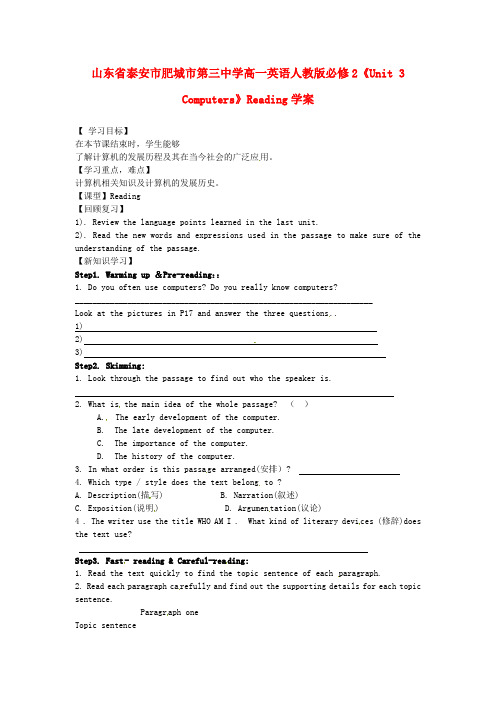
山东省泰安市肥城市第三中学高一英语人教版必修2《Unit 3Computers》Reading学案【学习目标】在本节课结束时,学生能够了解计算机的发展历程及其在当今社会的广泛应用。
【学习重点,难点】计算机相关知识及计算机的发展历史。
【课型】Reading【回顾复习】1). Review the language points learned in the last unit.2). Read the new words and expressions used in the passage to make sure of the understanding of the passage.【新知识学习】Step1. Warming up &Pre-reading::1. Do you often use computers? Do you really know computers?____________________________________________________________________Look at the pictures in P17 and answer the three questions..1)2)3)Step2. Skimming:1. Look through the passage to find out who the speaker is.2. What is the main idea of the whole passage? ()A. The early development of the computer.B. The late development of the computer.C. The importance of the computer.D. The history of the computer.3. In what order is this passa ge arranged(安排)?4. Which type / style does the text belong to ?A. Description(描写)B. Narration(叙述)C. Exposition(说明)D. Argumen tation(议论)4 . The writer use the title WHO AM I . What kind of literary devi ces (修辞)does the text use?Step3. Fast- reading & Careful-rea ding:1. Read the text quickly to find the topic sentence of each paragraph.2. Read each paragraph ca refully and find out the supporting details for each topic sentence.Paragr aph oneTopic sentenceSupportingdetails 1.calculating machine(1642 in France)2.3.4.PC5. .Paragraph twoTopic sentenceSupportingdetails tubes 2.3. workParagraph threeTopic sentenceSupportingdetails 1. communications 2.3. 4. robots5. 6.7. space rockets3.Read the text again and do the True or false exercises:1.Alan Turing built an Analytical Machine to solve any mathematical problems. ( )2.People began to realize that the computer got cleverer and quicker with ti me passing. ( )3.The computer began to serve th e human race since it was brought into people’s homes. ( )4.Since the 1970s, the computer was used by people around the world through the Internet. ( )5. The larger the computer is, the more memory it has. ( )【当堂达标】SummaryI was born as a ___________ machine in 1642. When I was young, I was good at____________ difficult sums.About 2 hundred years had passed before I could think _________ and produce_______ answers. At that time, I was called an ___________ machine. In 1936, I was built as a ___________ machine . I had the ability to _______any mathematical problem. From then on, I grew rapidly both in _______ and memory. Later I stored my memory on __________instead of in _____. I became _______ in size but _________in intelligence.As time went by, I became even smaller, for I put my memory on a very small ______, which made me become PC and laptop.In the 1960s, I could be connected with other computers by a ___________. From then on, I was able to share my knowle dge with others through the _____ _____ ______. After that, I had many new______________. Now, I am glad to serve human beings asa ________ _________ and a pleasant ___________.【反思提升】 Discussion:1)How do you usually use computers in your daily life?________________________________________________________________________________________________________________________________________2)Work with your partners to list some advantages and disadvantages of the internet.Step4 【Homework】Read though the text, pay more attention on new language points.Finish the exercises on the newspaper about the text.Step 2. 1. It’s a computer 2. D. 3. time 4.C 5. PersonificationStep 3 Over time , I have been changed quite a lotAnalytical machine ; laptopThese changes only become possible as my memory improved .Transistors ;small chipsSince the 1970s many new applications have been found for meFinance trade mobile phones medical operationsF T F T FCalculating simplifying logically quicker analytical universalSolve size transistors tubes smaller higher chip network WorldWideWeb applicati ons devoted friend helperd 学习指导单词读熟并能默写结合所学过的知识作答!结合课文思考选择准确答案仔细阅读课文完成填空英语要说出来你一定能行!。
高中英语课件学案Unit 3 ComputersReading

Unit 3 Computers阅读课一、教学内容 Warming up; Pre-reading; Reading; Comprehending (pp. 17-19) 二、教学目标在本节课结束时,学生能够● 运用已有知识,并通过图片和提示问题预测文章主要内容。
● 通过段落中心句确定段落大意,运用找读技巧搜寻文章主要信息。
● 在具体的语境中猜测生词词义,并能够利用构词法猜测生词词义。
● 利用本节课所学的课文内容和相关词汇讨论计算机对生活的影响。
三、教学步骤 步骤一 热身请学生看PPT 上的图片,说出物品的英文名称。
若学生说不出个别物品名称,教师提供帮助。
然后请学生两人一组讨论三个问题。
设计意图:通过看图片和回答问题引出本单元话题。
问题三让学生发挥想象力预测计算机的发展旨在引起学生的兴趣。
步骤二 读前1. 请学生利用文内插图和热身中的图片预测阅读篇章的内容。
教师将学生的预测结果写在黑板上。
2. 请学生两人一组列出计算机的用途。
教师可以请一组学生在黑板上列出用途,之后由其他学生补充,呈现全班学生的想法。
3. 请学生排列六项发明的顺序,之后利用找读相同词汇的方法快速浏览课文,检查自己的预测是否正确。
设计意图:通过读前活动调动学生已有知识,预测阅读篇章的主要内容;同时向学生介绍利用找读相同词汇快速确定信息位置的方法。
步骤三 读中1. 请学生略读一遍课文,确定课文的主题,检查读前预测是否准确。
2. 重点词汇学习1) 请学生两人一组猜测课文中两组生词的意思,并说明猜词的方法。
2) 教师请两三个学生说出自己和同伴的猜词方法;之后教师向学生介绍利用构词法和上下文猜测词义的方法。
教师可以一个词为例示范如何根据上下文猜测词义。
然后让学生练习猜测其余词汇。
课文中的其它生词可以请学生自己查字典自学,在词汇课上讲解重点生词用法。
3. 请学生两人一组分段阅读课文,分别找出各段中心句及支持中心句的论据。
之后请几个根据构词法猜测词义The meaning of the words in group A can all be guessed from their formation.Each pair of words has the same root (词根).technology technologicalsimple simplifyperson personalreal reality happy happinessWhile-reading Read the passage quickly and check yourprediction. Was it correct? What is the main idea of the passage?This passage is about _________________________.III. While-reading the development of computers学生说出自己的答案,其他学生和教师补充。
unit3computer reading公开课

While-reading
In pairs guess the meaning of the following new words from the reading passage. Then check your guesses using your book. A B technological revolution simplify application personal solve reality explore happiness goal
Unit 3 Computers Reading(阅读课)
学习目标
1 运用已有知识, 并通过图片和 提示问题预测 文章主要内容 2 通过段落中心 句确定段落大 意,运用寻读 技巧搜寻文章 主要信息 3 在具体的语境 中猜测生词词 义,并能够利 用构词法猜测 生词词义 4 利用本节课所 学的课文内容 和相关词汇讨 论计算机对生 活的影响
解题技巧 找读相同词汇 快速确定信息 位置
III. While-reading读中
Read the passage quickly and check your prediction. Was it correct? What is the main idea of the passage?
the development of computers This passage is about _________________________.
While-reading
The meaning of the words in group A can all be guessed from their formation. Each pair of words has the same root(词根).
人教版高中英语 必修二 Unit3 《Computers ---Reading》 (共28张) PPT课件 图文
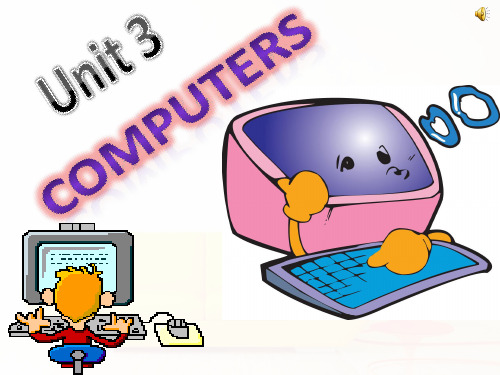
1.计算
calculate
2.通用的;宇宙的
universal
3.简化
simplify
4.总数;金额;算术题 sum
5.操作员,接线员
operator
6.合逻辑的;合情理的 logical
7.工艺;科技;技术 technology
8.科技的
technological
6. _m_e_d_i_c_a_l _o_peration 7. s_p_a_c_e_rocket
Fill in the blanks: I began as a c_a_l_cu_l_a_ti_n_g machine in 1642 in
France. In 1822 I was built as an _a_n_a_ly_ti_c_a_l machine. Then in 1936 Alan Turing wrote a book and built a _u_n_iv_e_r_s_a_l machine. As the years haveg_o_n_e_b_y_, I have been made s_m__a_ll_er_ . There were times when my size _t_o_ta_ll_y_ changed. And my memory became _s_o___ large _t_h_a_t _ I couldn’t believe it. In the 1960s they gave me a family_c_o_n_n_e_c_te_d_ by a network. I was able to _sh_a_r_e_m__y_k_n_o_w_l_ed_g_e_with others through the World Wide Web. Since the 1970s many new applications __h_av_e__b_ee_n__fo_u_n_d_ for me.
高中英语必修二Unit3 Computers Reading说课教案

Unit 3 ComputersReadingBackground information:This lesson is based on New Senior English for China Book 2 Unit3 Reading part. Words and expressions in this text are too obscure to understand. We can use pictures and the context to guide students to understand. There are three paragraphs in this text, each of which has a clear topic sentence that gives the main idea of the paragraph, so students should be guided to pay attention to them. Unlike other expositions, this text is written in time order and the first person, which should be introduced to students as well.Students in the first year of senior high school. It is the first time that students have read an exposition on science in senior school. They are not familiar with this type of writing. In addition, difficult terms and dull content in this text make it boring for students to read. Therefore, it is very important to arouse their interests and gain their confidence in reading.Teaching aims:1.Knowledge aims:a)Get the students to know the following new words and expressions in thistext:calculating machine, universal machine, analytical machine, artificial, intelligence, PC(personal computer), tube, transistor, chip, application, finance, trade, mobile, rocket, network...b)Get the students to have a better understanding of the history and basicknowledge of computers.2.Ability aims:a)Students can improve their reading ability by predicting, skimming andscanning.b) Students can find the topic sentence and supporting details of each paragraph.3.Emotional aims:a)Students’ sense of cooperative learning can be developed.b)Students will be proud of the development of the technology.Key points and difficulties:Key points:1. Let students learn more about history of the development and basic knowledge of computer;2. Enable the students to find the topic sentence of each paragraph;3. Enable them to improve their reading ability by predicting, skimming and scanning.Difficult points:1. Enable the students to have a clear mind about the topic sentence and the supporting details.2. Enable the students to explore, discuss and summarize the text structure. Teaching and learning methods:1. Task-based teaching and learning2. Cooperative learningTeaching Aids:1.Blackboard2.PPTTeaching procedures:Step 1: warming-upShow Ss the pictures of abacus, calculator, Mobile phone and computer, and ask Ss what they are. This can lead to today’ s topic and arouse Ss’ interest.Step 2: Pre-readingAsk Ss two questions:“Do you play games on computers?”Computers are very useful in our daily life. “Then in what other ways are computers used?”With this question, we can introduce some words which appear in the third paragraph: communication, trade, science and technology...[In this way, we can help students understand some difficult words which willhinder them from reading, and make them focus more on reading instead of on solving difficult words.From the above tasks, students have already been familiar with the text they will read, and thus they may not be afraid to read it.]Step 3: While-readingPredicting:I’ll let Ss to predict what the text will be about according to the title and the two pictures on page 18.Before prediction, we can ask students to describe the two pictures, which can increase the efficiency of their predicting.Skimming:I’ll ask Ss to read the text quickly and then answer the two questions:1)Who is the speaker?According to the previous study, this question is easy for Ss to answer.2)What is the main idea of the text?To simplify the question, I ask them to get the main idea in the following way:The text is about the ________ and the __________of computers.[These two questions can help students have a general understanding about the text.]Scanning:Scan the text and then finish the timeline:In 1642calculating machineIn 1882analytical machineIn 1936universal machineIn the 1940s as large as a roomIn the 1960s connected by a networkIn the 1970s new applications[From this question, students can have a detailed understanding about the text and it will help students clearly find that the text is written in time order.]Careful-reading:1)Please read the text for a third time carefully and then find the topic sentence of each paragraph.First read paragraph one in two minutes and find its topic sentence.[Students have known how to find a topic sentence of a paragraph, however, they still have no idea about the relationship between topic sentence and supportive sentences in a paragraph. For paragraph one, I will give guidance by asking them to pay attention to the first and last sentence of each paragraph, and finding the supportive sentences with them. Then, para.2 and 3 can be left to them.]2)Now it’s your turn to finish para.2 and 3 in three minutes. After that, have a discussion in groups of four to exchange your ideas.[By cooperative discussion, students who have known the topic sentence and supportive sentences may help those who do not know.]Step 4: post-readingThe above reading activities are all about input, and now it is high time they should output what they have learned in this text. So I designed a retelling as follows:1)Over time I have been ______ quite a lot. I began as a __________machine in 1642. In 1882 I was built as an _________ machine and then in 1936 Alan Turing wrote a book about how I could be made to be a _________ machine. These changes only became possible as my _______ improved. In the 1960s they give me a family connected by a _______. In the 1970s many new _________ have been found for me. My goal is to provide humans with a life of _____ ______. Now I am a devoted friend and ______ of the human race.Besides language output, I also design a summary about text structure to raise their awareness of a whole text.3)The text was written in _____ order and used_______ person(人称)in _______ and ________________tense(时态).The type of writing (文体) of this text was an ________.Step 5: homeworkDo a survey:Look up information about the development of mobile phones on theInternet, and make a report. Share with us in the next class. Blackboard design:Unit 3 ComputerWho am I ?-----personification Para.1 changed a lotcalculating machine analytical machineuniversal machine PC(personal computer) laptop Para.2 memory improvedtubes--transistors--chips—network--WWWPara.3 applicationscommunication finance / trade science and technology。
高中英语 必修二 Unit3 《Computers-Reading》
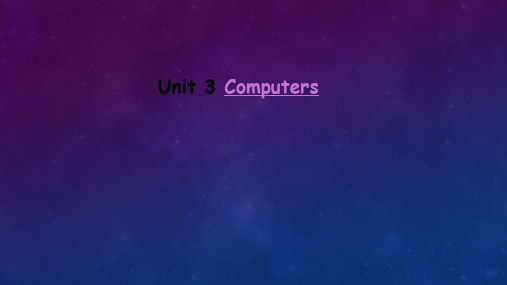
Homework
1. Read the passage fluently after class; 2. Finish <名校学案> reading.
Mobile/cell phone
I am an electronic machine that can store, organize and find information, do calculations and control other machines. My nickname is “PC”.
calculator
I am a machine that you can use to talk to other people even in a far away place. You can carry me around you. Now each of us often has a number. Do you know who I am?
After Reading
Summary of the text
It’s known to us all that the computers is one of the most important
inventions in the 20th century. Though it’s widely used in our daily life, it began only as a c_a__l_c_u_l_a__tinmgachine in 1642. In 1822,
Unit 3 Computers
These amazing inventions we saw in the video come from the following common things:
- 1、下载文档前请自行甄别文档内容的完整性,平台不提供额外的编辑、内容补充、找答案等附加服务。
- 2、"仅部分预览"的文档,不可在线预览部分如存在完整性等问题,可反馈申请退款(可完整预览的文档不适用该条件!)。
- 3、如文档侵犯您的权益,请联系客服反馈,我们会尽快为您处理(人工客服工作时间:9:00-18:30)。
abacus
I can be used for calculating. Besides, I can also be used for watching DVD, sending e-mail and communicating through the Internet. However, I am not a PC, because I’m small enough for you to take me with you.
calculator
I am very big. Scientists use me to solve some mathematical problems. Do you know who I am?
huge computer
I’m a machine that works automatically(自动地). I can do a wide variety of tasks, especially suitable for doing jobs too boring, difficult, or dangerous for human beings. Do you know who I am?
carry things
work in wars (战斗)
仿真机器人
entertainment
娱乐 What do you think will be the next development?
Unit 3 Computers
Warming Up & Pre-reading & Reading
robot
I’m a small, relatively inexpensive computer designed for an individual user. I’m based on the microprocessor(微处理 器) technology. At home, people use me to surf the Internet and play games. Do you know who I am?
PC
Personal Computer
Can you tell the development of computers?
abacus calculator huge
PC
computer
What’s next?
robot
laptop
What’s next?
work for us in Mars(火星)
2. What’s the main idea of this passage? A. The development of computers. B. The development and use of computers. C. A machine which is simple-minded. D. Computers may replace human beings.
send emails
……
play games
watch movies
communicate with my friends.
search for information
do shopping online
listen to music
Riddles (谜语)
I am very old now. I was born in China. Many people used me for calculating in the past, but now I am a bit lonely because they don’t like me now.
Guess!
A handbag?
A toy?
camera
monitor
screen
host computer
keyboard
speaker mouse
other useful words and expressions about computer:
Network 网络 Virus 病毒 Download 下载 Up load 上传 Program 程序 Website 站点 Hacker 黑客
Do you know who I am?
laptop
I am very small. I can be used for calculating. In China, a lot of students use me when solving mathematical problems. Do you know who I am?
Home page 主页 Password 密码 Desk top 桌面 User name 用户名 Click 点击 Software 软件
Hardware 硬件 Home page 主页
Discussion
In what ways are computers used today?
We can use the computer to…….
Just have a fast reading
Find out topic sentences of each paragraph.
1. Over time I have changed quite a lot. 2. These changes only became possible as my memory improved. 3. Since the 1970s many new applications have been found for me.
g
Reading Comprehension II Finish the timeline below.
Timeline
1642: T_h_e__co__m_p_u__te_r__b_e_g_a_n__a_s_a__c_a_lc_u__la_t_i_n_g_m__a_c_h_i_n_e_
1970s: _C_o__m__p_u_t_e_r_s__w__e_r_e__u_s_e_d__i_n__o_f_f_i_c_e_s_a__n_d__h_o__m__e_s_._
Now: C__o_m__p__u_t_e_r_s__c_o_n__n_e_c_t__p_e_o_p__le__a_l_l_o__v_e_r__t_h_e__w__o_r_l_d_ ___to__g_e_t_h_e_r__. ______________________________
Who am I ?
Skimming
Reading Comprehension I
1.Who is the speaker in this story?
2. What’s the main idea of this passage? A. The development of computers. B. The development and use of computers. C. A machine which is simple-minded. D. Computers may replace human beings.
1822: The Analytical Machine was made by Charles Babbage.
1936: _T__h_e__c_o_m__p__u_t_e_r__g_r_e_w___r_a_p_i_d_l_y__b_o__th__i_n________ _s_i_z_e__a_n_d__i_n__b_r_a__in__p_o_w__e_r_.______________
1940s: __T_h__e__c_o_m__p_u__t_e_r_h__a_d__g_r_o__w_n__a__s_l_a_r_g__e_a__s_a__r_o_o__m_ .
1_9_6_0_s_: The first family of computers was connected to each other.
